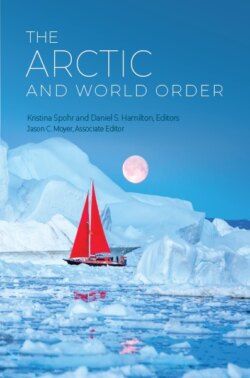Читать книгу The Arctic and World Order - Группа авторов - Страница 24
На сайте Литреса книга снята с продажи.
Towards a Vision for the Arctic
ОглавлениеCan the Arctic avoid this well-worn pathway, finding a way to conserve its distinctive features while also providing opportunities for Arctic peoples? Are our current institutions up to this task? The first is an open question. Recent and current performance suggests the answer to the second question is no.
The first step off of the path to creeping degradation is a recognition that society is indeed on that path. With sparse populations and difficult access, the human presence on the Arctic landscape is often not evident. A closer look tells a different story. Roads, mines, sportfishing camps, and other human constructions can be found all around the Arctic. As mentioned, pollutants and plastics are found wherever we look. Governments and companies prepare plans that cover the map with further development. We conduct environmental impact assessments and conclude that one new activity will produce little additional harm. And we fail to look at the weight of history, the lessons from elsewhere, and the idea that many small cuts can cause major damage.
The second step off the well-worn path is to develop a vision for what the Arctic can be.24 An insidious aspect of creeping degradation is that we scarcely notice what has happened. For every dramatic case like the collapse of cod around Newfoundland, there are many huge fish runs that have slowly turned to a small remnant capable of supporting only a symbolic fishery.25 Oilfields once concentrated around Prudhoe Bay in northern Alaska now stretch hundreds of miles along the coast and inland and are expanding offshore.26 We take for granted that which is abundant and content ourselves with a small fraction of what once was and what could be again. Lowered expectations lead to lower outcomes, which lower our expectations further still. Our vision for the Arctic should be based on high expectations.
Our current institutions fall short on both accounts. First and foremost, we lack a compelling vision for an abundant Arctic. Leaders and officials say the right things about managing against cultural and environmental loss, but very little about what we are managing for. Our expectations center on how to manage increased shipping, expanded fishing, additional oil and gas extraction, more mines, or greater numbers of tourists. We do not discuss whether there should be limits instead of an endless growth of the human footprint, or what a vibrant Arctic society could look like other than a copy of societies farther south. Instead, we carry on as if the Arctic can absorb whatever we decide to do there, as if all our experiences elsewhere in the world are irrelevant in the North. None of our existing institutions do much to push us out of our comfort and complacency that somehow all will be well, that a well-trodden path must be a good path.
Second, we have no effective way of assessing, measuring, and managing the cumulative effects of dozens, hundreds, and thousands of small actions taken all around the Arctic, over both the shorter or longer term. Science is not yet up to this task, and none of our institutions have the scope to manage human activities as a single enterprise. Instead, we congratulate ourselves for Bering Strait shipping lanes, even as there is no discussion of whether and how to limit overall traffic. We commend the sound management of bowhead whale hunting, even as more whales are entangled in fishing gear and struck by ships. We allow fisheries where narwhal winter and ore-carrying ships where narwhal summer, but do nothing to connect the two disturbances or manage for both together. We are well-positioned for many institutions to make a series of individually reasonable decisions that together produce well-controlled decline in our expectations and the Arctic environment.
In theory, these problems are exactly what integrated ecosystem management is meant to address.27 The idea that there may be cumulative effects is hardly news. Yet we struggle with how to “integrate” and how to “manage.” At its heart, the question is one of tradeoffs. We cannot have everything that we may want, so we need to make choices. Are fish the priority, or is it oil? How far should seal hunting be disrupted to accommodate shipping? How do we quantify, measure, and compare the risks? There are no obvious answers. A common response is to continue to insist that we can in fact have it all, that offshore oil and gas need not pose a threat to fisheries or to marine mammals, that seals and seal hunters can get used to the sight and sound and smell of large ships. This is nonsense. Yet without a vision for an abundant Arctic, we fight over dozens of lesser visions pitting today’s profits against tomorrow’s well-being.
Even if we should agree on that vision for abundance, we lack an understanding of ecosystems and of human societies, not to mention the underlying data, to make precise predictions about what and how much activity the Arctic can tolerate before it begins to degrade. As we can see elsewhere in the world, instead of leaving some slack in the system to accommodate uncertainty and variability, we push up to and beyond any limits we identify. If we cannot show there will be an impact, we go ahead. This is backwards. Some decisions recently have taken the other approach, i.e. that until we can be reasonably sure we are not causing harm, we should hold off. The Central Arctic Ocean Fisheries Agreement is one such example. It is notable, however, that there were no fisheries in the region when the agreement was signed, nor any in nearby waters. The principle is a welcome one in an international agreement, but in practice nothing was actually given up. It is harder to imagine an agreement to call a halt to activities already underway, all in the name of caution.
